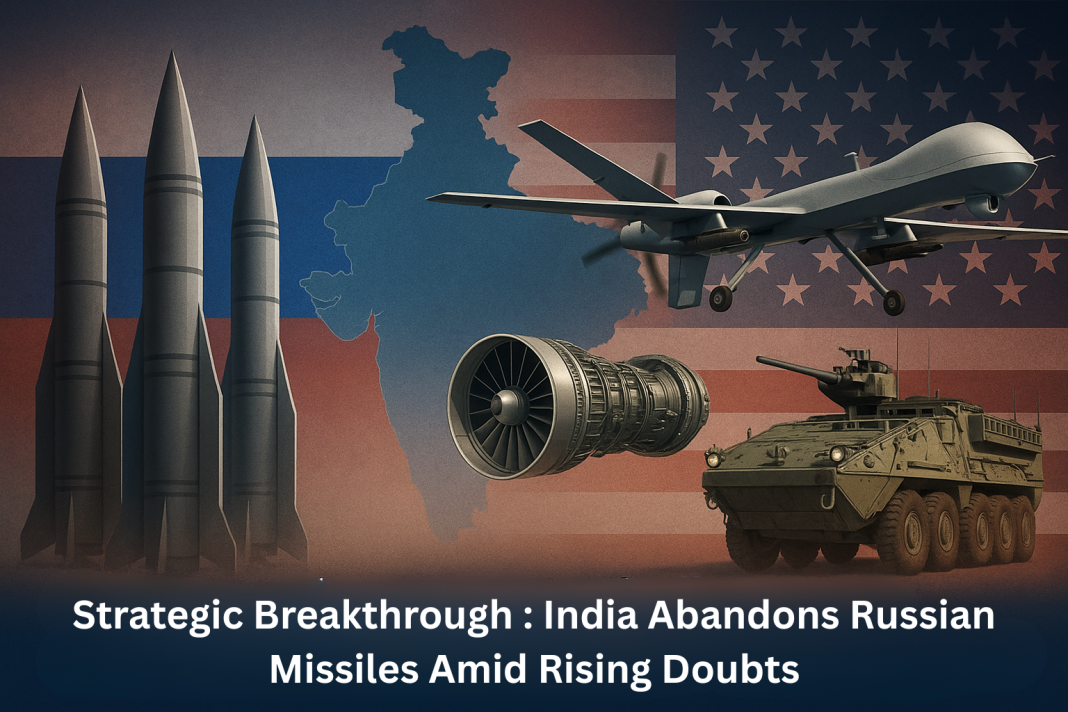For many decades, India has relied heavily on Russia for its weapons and military machines. Russia was India’s biggest supplier of fighter jets, Russian missiles, submarines, and many other defense tools.
India’s Defense Move: Turning Away from Russian Missiles
But now, a big change is happening. India is reducing its dependence on Russian missiles and other arms and is instead turning towards the United States and Europe. Experts are calling this a major and historic shift.
This change is driven by several reasons. India has faced delays in receiving weapons, Russian missiles, and spare parts from Russia. Also, there are growing worries about the quality of Russian equipment. On top of that, the ongoing war in Ukraine has hurt Russia’s ability to produce and deliver military gear smoothly. Indian officials have also raised concerns about Chinese parts creeping into Russian weapons, which is a serious worry for India since it shares a tense border with China.
Just ten years ago, around 76% of India’s military imports came from Russia. But last year, that number dropped sharply to only 36%, the lowest in more than 50 years. This data comes from the Stockholm International Peace Research Institute, a respected organization that tracks global arms sales. This shows how quickly India is moving away from Russian supplies.
Pakistan & China Rattled as India’s Brahmos Mach 3 Missile Gets Russian Upgrade – And It’s Lethal
US and Europe Step In with Big Deals
With Russia stepping back, Western countries like the US and France see a huge opportunity. They are eager to sell their advanced weapons to India. Recently, India signed many multi-billion-dollar deals for different defense equipment. These include drones, jet engines, powerful guns called howitzers, aircraft used for spying and surveillance, and alternatives to Russian missiles that India has long relied on.
The relationship between India and the US has become particularly strong. The US is sending 31 MQ-9B drones to India, which are powerful unmanned aircraft used for monitoring and defense. India’s own company HAL is working with the American company General Electric to build GE-F414 jet engines together. This is part of a 10-year plan to share and develop military technology between the two countries and reduce dependence on Russian missiles.
US officials have made it clear how important India is becoming as a customer. The US Commerce Secretary, Howard Lutnick, said, “India is finally buying from the United States. That changes everything.” India has been granted STA-1 status by the US, which means it can get sensitive American technology more easily. This special status helps speed up defense deals, including discussions on co-producing weapons that can replace older Russian missiles in India’s arsenal.
Besides drones and jet engines, talks are ongoing for India to co-produce other weapons with the US, like Javelin anti-tank missiles and Stryker combat vehicles. There is also a push for more cooperation in building aircraft for maritime surveillance. All this shows India’s plan to create a defense industry within the country, powered by Western technology.
India’s S-400 Air Defense System Stops Missiles and Drones — But Each Intercept Costs $1.75 Million
China’s Threat Pushes India’s Defense Strategy
One of the main reasons India is rushing to modernize its military with Western help is China. Beijing has been very active and aggressive in the Indo-Pacific region. India sees this as a direct threat. To prepare for this, India is working closely with the United States in many ways.
The two countries are conducting joint naval exercises, working on anti-submarine warfare, and developing battlefield technologies that use artificial intelligence. Indian defense startups are teaming up with US companies like Anduril and Mahindra to create autonomous systems — machines that can operate with little human control.
Together, India and the US want to build a defense technology ecosystem that combines American resources and scale with Indian creativity and innovation.
However, there are still challenges. The US has strict rules about what technology it can export. These export controls and intellectual property restrictions make it harder for India to access some advanced American technologies. Past initiatives like the Defense Technology and Trade Initiative (DTTI) faced problems because of government red tape and lack of strong political commitment.
Despite these obstacles, India’s defense budget is huge — about $100 billion — and China’s threat is real and growing. India wants real results and not just promises or agreements.
Continued But Reduced Russian Ties
Even though India is moving towards Western weapons, it hasn’t completely cut off Russia. Russian oil still arrives at Indian ports, and India continues to use many Russian-made military systems, including older Russian missiles. For now, India still needs Russian missiles spare parts to keep those weapons working.
Confirmed Strike: Indian S-400 Downs PAF’s U.S.-Made F-16 Near Sargodha Air Base
But experts say Russia’s role in India’s defense future is shrinking. From being the top supplier of new weapons, Russia may now mainly supply spare parts and some special systems like nuclear submarines, along with limited Russian missiles.
This is a big downgrade in India’s defense sourcing and shows how Russia’s position as India’s main arms partner is fading.
This shift in India’s defense strategy shows how global alliances are changing. The West, led by the United States, is eager to fill the gap left by Russia and build a stronger defense partnership with India. Meanwhile, India is using this moment to modernize its military with new technology and partnerships, driven largely by concerns over China and supply issues with Russia.

